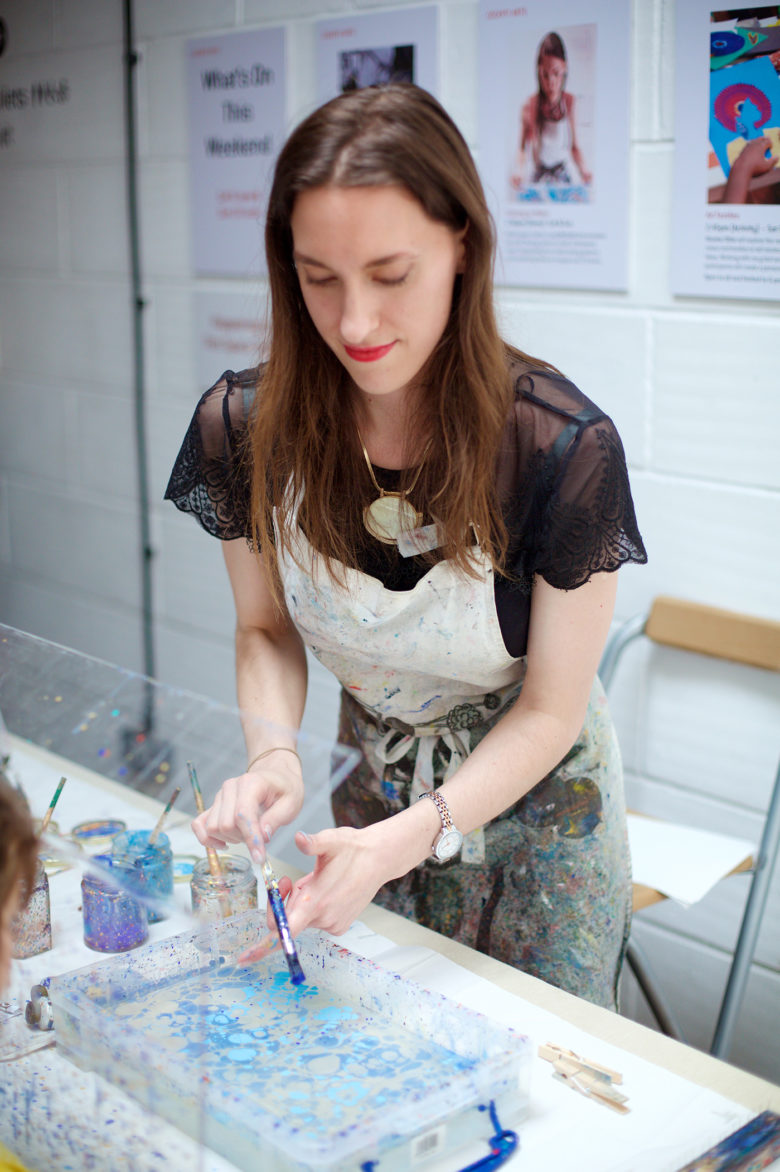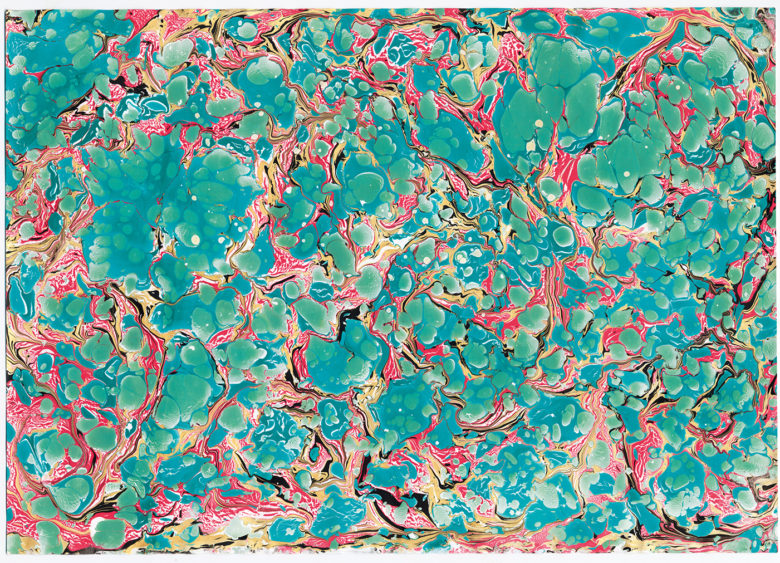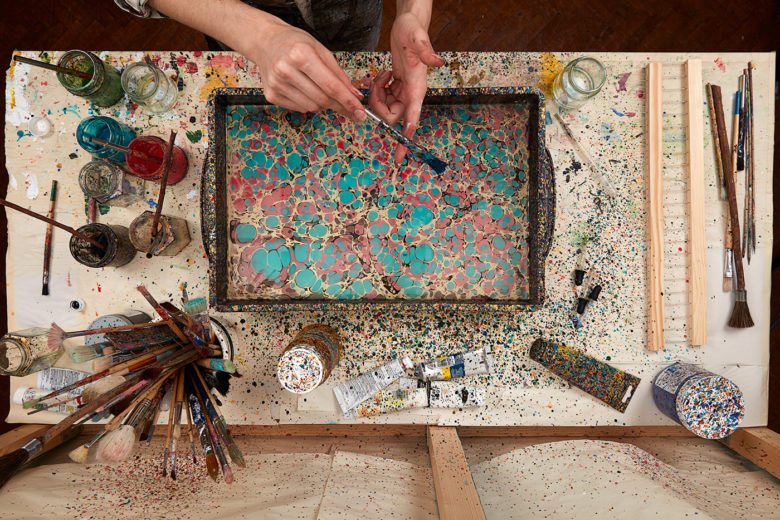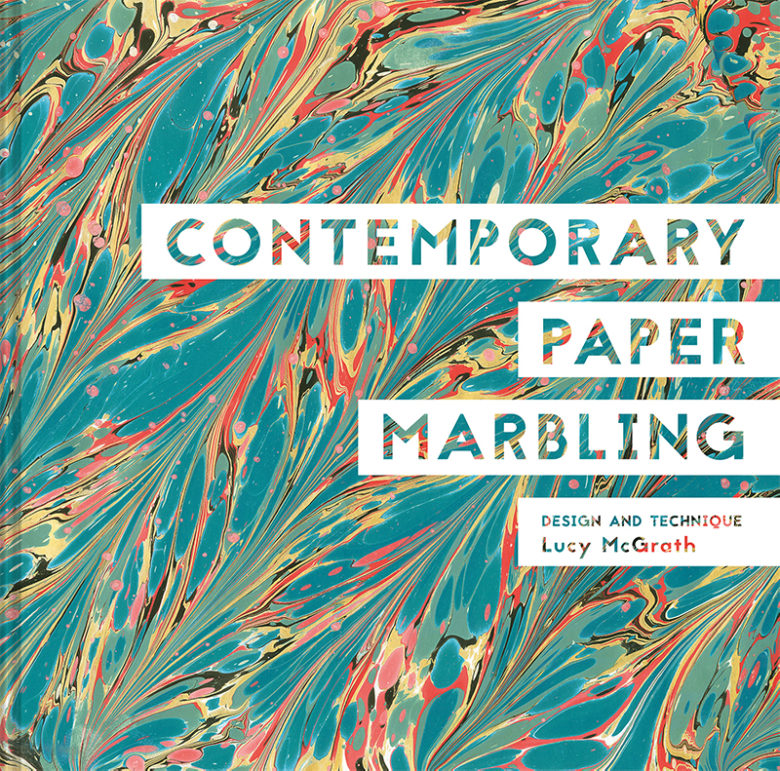

It’s the antidote to perfectionism, says Lucy McGrath, one of the tiny number of professional marblers left in the UK. She speaks to Jessica Jonzen about why she’s bringing this ancient craft to a modern audience and why we need to remember the importance of playfulness.

As is often the case with creatives, the clue to Lucy McGrath’s future career was always right under her nose. “My dad was a Classics teacher and we were always surrounded by these beautiful old books. I used to take them out and hold them and they had that wonderful old book smell,” she says.
The dusty tomes of Greek classics like Homer’s Odyssey and The Iliad which lined the bookshelves of her childhood home had always held a special place in Lucy’s imagination. “I always felt like I was being transported back in time when I looked at them – they also had these beautiful marble end papers.”
Whilst studying illustration at the University of Brighton, Lucy found herself drawn to the bindery, and took supplementary classes in bookbinding. “I quickly discovered that illustration wasn’t for me – I was way too much of a perfectionist,” says Lucy. “Eventually nearly every project I did was based around a book of some kind – I preferred making things with my hands rather than labouring over tiny perfect little drawings.”
After she graduated, Lucy made books as a hobby and started collecting Victorian bindings with their beautiful marble papers. “I’d tried marbling at university but had failed miserably at it and wanted to try it again.” It was on a holiday to Istanbul a few years later that the opportunity arose. Having originated in Turkey, marbling is a popular craft there and so the hotel where Lucy was staying had an in-house marbling tutor. “I tried it out and I loved it and couldn’t wait to do more.”
Marbling is on the Heritage Craft Association’s Red List as an ‘endangered craft,’ with less than 10 professional paper marblers working in the UK. Lucy tracked down British marbler Victoria Hall and did a two-day course and in November 2015, she launched her business, Marmor Paperie (‘marmor’ is Latin for marble) creating contemporary marbled papers, journals and objects.
Lucy won the Arts Society/Cockpit Arts Award in 2016 which provided her with tailored business support to help grow, as well as funding a studio at craft incubator Cockpit Arts for a year. After the year was up, the business had grown to the point where Marmor Paperie could stay on and it has continued to go from strength to strength.
Lucy has done projects for Matches Fashion and Molton Brown, and her work has featured in publications including Homes & Gardens, Stylist and Country Life. Lucy’s debut book Contemporary Paper Marbling is out now and she tells us why this ancient craft is so addictive…
What is it about marbling that you find so captivating?
I think of marbling as a collaboration between you and the marbling size [the thickened water used in the process]. It’s never just you – it’s the randomness of the fluid itself that makes these beautiful patterns. Marbling is very good for people who are trying to get over perfectionism because you have to let go and go with the water and let the shapes happen and it’s really freeing. It’s frustrating at first but it’s a good practice to let things happen – the more you try to control it the less it will do what you want it to do. We live in an era where everything is done via a screen and you can put filters on things to make them look better and it’s not like that at all with marbling. It goes back to just making a mess with your hands and what’s done is done. It’s never boring.
The colour combinations you use are so striking – where do you get colour inspiration?
Mostly from natural sources – my favourite combination is one I call ‘Abalone’ after the beautiful shells with their iridescent blues, pinks, greens and golds. I try to pick out those colours in my Abalone colourway. I used to be quite scared of colour it but I think that makes me push myself to try new things out. There are so many inspiring colour combinations in the natural world – a cloud, ripples in water, the half yellow, half orange trees you get at this time of year. I think there is a massive link between natural stones like agate and marble and even granite and the work I do, so I often take inspiration from these natural sources and a lot of it ends up in my studio – not my house as my boyfriend is a staunch minimalist!

What are some of the most exciting projects you’ve worked on?
There was a crazy one I worked on recently for an artist collective who were doing a performance piece in the Gloucestershire Archives and they wanted to marble a ballet dancer, so they needed a human size marbling tray. I consulted with them and did some workshops with them so they could do the marbling themselves for the performance. I’ve made some really nice paper lanterns for Tate Shop in different sizes. I’d done some for Matches Fashion for an event and they obviously saw a picture and wanted to sell some. I made lots of ribbons for Molton Brown for their recent perfume launch, and silk scarves for their staff. Everything is original – I don’t do any printing, which means every item is unique.
What would your advice be for someone trying marbling for the first time?
My book is based around the Turkish tradition involving thickened water, but you can just start with oil paints on plain water. You won’t get the very controlled beautiful patterns you get with Turkish marbling, it’s very swirling and formless but it’s beautiful in its own way. Get some oil paints and half fill a tray with tap water. Thin down your paint with turpentine until it jumps off the brush when you knock it with your finger and forms beads on the surface. It’s a good way in, but Turkish marbling is what my book is about and how you’ll get the most beautiful patterns.

What are your hopes for marbling as a craft?
I’ve already been so buoyed by how much attention and interest there is from people about marbling and I think mostly it’s due to Instagram. When I started Marmor Paperie I wanted to bring marbling to a wider audience – I wanted people to know what it is. A lot of people were coming up to me in the market stalls and saying ‘what is this, how have you printed this?’ and I had to explain the process – it’s not something that people do at school anymore. There’s a real move towards STEM subjects – subjects where you get a job at the end. But you need art, it’s in everything and there is room for crafts like marbling.
I believe there is a real backlash against mass-produced products. They all look the same – there’s no specialness or interest to them and I think people would like to have more of a connection with their objects. Increasingly, they want to know how they’re made and that each one is special. With marbling, you never get two the same – yours will always be the only one in the world. It’s nice to be able to offer that to people.
Contemporary Paper Marbling by Lucy McGrath, published by Batsford, RRP £20, is available now.

A look back on our June #CountryCreatures Chef Series with @rosechalalai. A summer evening to remember with beautiful Thai flavours cooked over fire. We`re back again in Autumn with @margotehenderson joining us at the pass! Limited availability, bookings via the link in our bio 🌿 #DoubleRedDuke #ChefSeries

Danny gracing the terrace before the afternoon revelry begins @masonsarmsclanfield ☀️ #CountryCreatures #TheCotswolda

The inaugural classic from the Côte Citron Country Creatures Cricket Club, otherwise known as the Six Cs, took place last Friday beneath a blazing Oxfordshire sun. A competitive day (in spirit, if not in skill) saw some of the country’s finest chefs and critics trade kitchen tools for cricket bats. While the gameplay wasn’t exactly textbook, the rosé flowed, the @cote__citron beers were cold, and the company more than made up for it! A big thank you to all who participated 🏏🌿 #CountryCreatures #CôteCitron

When Monday shows up uninvited, but you’ve got other plans... 🌿 #CountryCreatures #DoubleRedDuke
